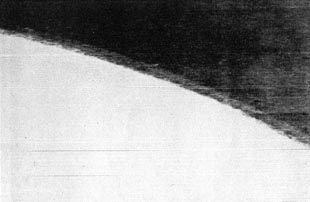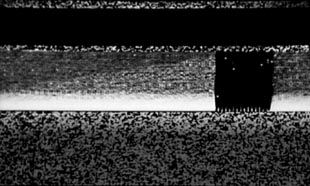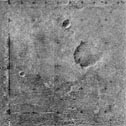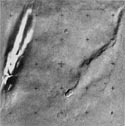|
Soviet Mars probes in the 1960s were far ahead of their time but suffered a series of unlucky failures. After some success in 1971 and 1973, the Russians focused primarily on the study of Venus.
Mars-3
The first Soviet orbiters, Mars-2 and Mars-3 arrived on November 27 and December 2, 1971.
They carried the 52mm "Vega" and 350mm "Zulfar"
phototelevision cameras
(later used on Mars-4 and 5), carrying enough film for 480 photos per camera.
These cameras were designed by A.S. Selivanov and his team at the Institute of Space Device Engineering.
The original plan was to spend the first 40 days performing photographic surveys;
however, Mars was experiencing a severe planet-wide dust storm when the Soviet probes (and the American Mariner-9) arrived. The photo below left shows the atmospheric limb during the dust storm, from a distance of 150,000 km (the orbit of Mars-3 was highly elongated).
Mars-2 did not return much data because of problems with its telemetry systems.
 Atmospheric Edge
Atmospheric Edge
|
 Mountains in Equatorial Region
Mountains in Equatorial Region
|
Contrary to some reports, the phototelevision cameras on Mars-3 were functional after the dust storm subsided, in December. At least four photographic surveys have been reported (Dec 12, 14, Feb 28, Mar 12).
Images were returned by pulse-code modulation over the decimeter-band telemetry channel, after the centimeter-band pulse-position modulation system failed.
The decimeter transmitter suffered from intermittant failures and was used very cautiously. Only after important science data was gathered, a small number of images at low resolution were transmitted
(256-line mode).
The color image below is a composite from the 52 mm camera, using its program of cycling red, green and blue glass filters. The red-filter image, published elsewhere, is evidently one of the channels used in the composite:
 Color Composite
Color Composite
|
 The Red-Channel Image
The Red-Channel Image
|
A descent vehicle released by Mars-3 became the first probe to land on Mars, but it only operated for about 20 seconds, returning some data and 79 scan lines of video.
The image below right is reported to be a view of that signal. It should probably be rotated 90° since the Mars-3 cameras were of the same
cycloramic design
as Luna-9, scanning vertically. After extensive analysis, Soviet scientists report that it contains no information. It is not likely a view of the Martian horizon as some people have suggested:

Signal from mars-3 Lander
Mars-4
The first in an armada of four spacecrafts launched in 1973, Mars-4 failed to enter orbit. During its flyby on February 10 1974, it returned 12 photographs from the 52mm "Vega"
phototelevision camera,
all through the red filter. It also returned 2 panoramas from the optical-mechanical cameras. Image data was returned digitally by pulse position modulation.
 Frame 1.V
Frame 1.V
|
 Frame 2.V
Frame 2.V
|
 Frame 3.V
Frame 3.V
|

Frame 4.V
|
 Frame 5.V
Frame 5.V
|

Frame 6.V
|
 Frame 7.V
Frame 7.V
|

Frame 8.V
|
 Frame 9.V
Frame 9.V
|

Frame 10.V
|
 Frame 11.V
Frame 11.V
|

Frame 12.V
|
Two
optical-mechanical linear cameras
swept out panoramas of Mars as the spacecraft passed by. These were very similar to cameras later flown on Venera-9 and 10 orbiters, but one of the Mars versions had a photomultiplier tube sensitive to infrared.
Red and orange filter images have been published, but apparently no infrared panoramas were received from Mars-4 or Mars-5.
 Panorama 1 (orange filter)
Panorama 1 (orange filter)
|
 Panorama 2 (red filter)
Panorama 2 (red filter)
|
Mars-5
Mars-5 entered an elliptic Martian orbit on February 12, 1974. Nearly synchronized with the rotation of the planet, its two
phototelevision cameras
could be commanded to take 12 pictures during each close approach. The "Vega" camera used a wide area 52mm lens with color filters, the "Zulfar" camera used a telescopic 350mm lens and long-pass orange filter.
Images were transmitted in a rapid 220-line mode, and then selected pictures were retransmitted at 880 or 1760 line resolution. Unless otherwise indicated, the Vega pictures are shot through its red filter. Images transmitted only in 220-line resolution are presented as icons with no image link.
February 17, Program 1
 Frame 2.V
Frame 2.V
|
 Frame 4.V
Frame 4.V
|
 Frame 6.V
Frame 6.V
|

Frame 7.V
|
 Frame 8.V
Frame 8.V
|
 Frame 9.V
Frame 9.V
|
 Frame 11.V
Frame 11.V
|

Frame 2.Z
|
 Frame 3.Z
Frame 3.Z
|
 Frame 4.Z
Frame 4.Z
|
 Frame 5.Z
Frame 5.Z
|

Frame 6.Z
|
 Frame 7.Z
Frame 7.Z
|
 Frame 8.Z
Frame 8.Z
|
 Frame 9.Z
Frame 9.Z
|

Frame 10.Z
|
 Frame 11.Z
Frame 11.Z
|
February 21, Program 2
 Frame 2.V
Frame 2.V
|
 Frame 4.V
Frame 4.V
|
 Frame 6.V
Frame 6.V
|

Frame 8.V
|

Frame 10.V
|
 Frame 12.V
Frame 12.V
|
February 23, Program 3
 Frame 2.V
Frame 2.V
|
 Frame 3.V
Frame 3.V
|
 Frame 4.V
Frame 4.V
|
 Frame 5.V
Frame 5.V
|
 Frame 6.V
Frame 6.V
|
 Frame 7.V
Frame 7.V
|

Composite 9,10,11
|
 Frame 9.V (green)
Frame 9.V (green)
|
 Frame 10.V (red)
Frame 10.V (red)
|
 Frame 11.V (blue)
Frame 11.V (blue)
|
 Frame 2.Z
Frame 2.Z
|
 Frame 3.Z
Frame 3.Z
|
 Frame 4.Z
Frame 4.Z
|

Frame 5.Z
|
 Frame 6.Z
Frame 6.Z
|
 Frame 7.Z
Frame 7.Z
|
 Frame 8.Z
Frame 8.Z
|
 Frame 9.Z
Frame 9.Z
|
 Frame 10.Z
Frame 10.Z
|
 Frame 11.Z
Frame 11.Z
|
February 25, Program 4
 Frame 2.V
Frame 2.V
|
 Frame 4.V
Frame 4.V
|
 Frame 6.V
Frame 6.V
|
 Frame 8.V
Frame 8.V
|
 Frame 10.V
Frame 10.V
|
 Frame 12.V
Frame 12.V
|
 Frame 3.Z
Frame 3.Z
|
 Frame 4.Z
Frame 4.Z
|
 Frame 5.Z
Frame 5.Z
|

Frame 6.Z
|

Frame 7.Z
|
 Frame 8.Z
Frame 8.Z
|

Frame 9.Z
|
 Frame 10.Z
Frame 10.Z
|
 Frame 11.Z
Frame 11.Z
|
 Frame 12.Z
Frame 12.Z
|
February 26, Program 5

Frame 2.V
|
 Composite 3,4,5
Composite 3,4,5
|
 Frame 3.V (green)
Frame 3.V (green)
|
 Frame 4.V (red)
Frame 4.V (red)
|
 Frame 5.V (blue)
Frame 5.V (blue)
|
 Frame 6.V
Frame 6.V
|
 Composite 10,11,12
Composite 10,11,12
|
 Frame 10.V (red)
Frame 10.V (red)
|
 Frame 11.V (blue)
Frame 11.V (blue)
|
 Frame 12.V (green)
Frame 12.V (green)
|
 Frame 1.Z
Frame 1.Z
|
 Frame 2.Z
Frame 2.Z
|
 Frame 3.Z
Frame 3.Z
|
 Frame 4.Z
Frame 4.Z
|
 Frame 6.Z
Frame 6.Z
|
 Frame 7.Z
Frame 7.Z
|
 Frame 8.Z
Frame 8.Z
|
 Frame 9.Z
Frame 9.Z
|
 Frame 10.Z
Frame 10.Z
|
 Frame 11.Z
Frame 11.Z
|
 Frame 12.Z
Frame 12.Z
|
Mars-5 Optical-Mechanical Panoramas
Two
optical-mechanical linear cameras
scanned the planet while the spacecraft moved in its orbit and remained in a 3-axis stabilized orientation. The camera scanned a 30° wide swath, returning 256 or possibly 512 pixels per scanline (including a squarewave calibration pattern during the retrace interval, not shown here).
 Feb 21 (red)
Feb 21 (red)
|
 Feb 23 (red)
Feb 23 (red)
|
 Feb 24 (orange filter)
Feb 24 (orange filter)
|
 Feb 24 (red filter)
Feb 24 (red filter)
|
 Feb 28 (orange)
Feb 28 (orange)
|
Fobos-2
The last successful Soviet space probe, Fobos-2 arrived in Martian orbit on January 30, 1989. It carried an
optical-mechanical linear camera
that operated simultaneously in red/near-infrared light (600 - 950 nm) and far thermal infrared (8.5 - 12 μ), using a cryogenically cooled detector. Four pairs of panoramas were received. The elongated horizontal smudge seen in some images is the shadow of Phobos, traveling in nearly the same orbit as the spacecraft:

Feb 11 (Thermal IR)

Feb 11 (Red)

Mar 1 (Thermal IR)

Mar 1 (Red)
 Mar 26 Daytime (Thermal IR)
Mar 26 Daytime (Thermal IR)

Mar 26 Daytime (Red)
 Mar 26 Evening (Thermal IR)
Mar 26 Evening (Thermal IR)

Mar 26 Evening (Red)
VSK Images
Fobos-2 carried the video-spectrometric complex (VSK), three CCD cameras and a spectrometer. It was built by a team from Buylgaria, East Germany and the Soviet Union, and extensive image processing was performed at IKI and the Keldysh Institute.
Channel 1 was wide angle with a blue-green filter (400-600 nm), channel 2 was narrow angle with clear filter (400-1100 nm), and channel 3 was wide angle with near-infrared filter (800-1100 nm).
The raw data is almost unviewable, so I have done some computer processing for horizontal sync, dark current and charge-transfer effects, as discussed in Televizionnye Issledovaniia Fobosa. Each image includes channels 1 to 3, and a corresponding IKI processed image.
Additional work is needed to correct spurious data in channel 1 (causing the jagged misalignment of some scanlines). This may not be possible using NASA's copy of the data, which has parity bits removed.
IKI performed additional processing in the frequency domain to remove periodic noise and replace bad pixels and scanlines with local median values.
The final two are a channel-3 image of Mars and a channel-2 image of Jupiter.
White pixels appearing in columns 228-231 of the channel-3 CCD are caused by a fault in the electronics, but gained notoriety when misidentified by UFO experts as an alien spacecraft.
Acknowledgements
Thank-you to Andrew Ball and Basil Pivovarov for finding the rare Mars-3 images.
Mars-4 and 5 images are inverse halftoned and processed from various source materials, such as Pverkhnosti Marsa. Termoskan and VSK raw image data from Fobos-2 was published by the National Space Science Data Center.
|


 Mountains in Equatorial Region
Mountains in Equatorial Region
 Color Composite
Color Composite
 The Red-Channel Image
The Red-Channel Image














 Frame 2.V
Frame 2.V
 Frame 4.V
Frame 4.V


 Frame 8.V
Frame 8.V
 Frame 9.V
Frame 9.V
 Frame 11.V
Frame 11.V










 Frame 2.V
Frame 2.V
 Frame 4.V
Frame 4.V



 Frame 12.V
Frame 12.V
 Frame 2.V
Frame 2.V
 Frame 3.V
Frame 3.V
 Frame 4.V
Frame 4.V
 Frame 5.V
Frame 5.V
 Frame 6.V
Frame 6.V
 Frame 7.V
Frame 7.V




 Frame 2.Z
Frame 2.Z

 Frame 4.Z
Frame 4.Z

 Frame 6.Z
Frame 6.Z

 Frame 8.Z
Frame 8.Z

 Frame 10.Z
Frame 10.Z

 Frame 2.V
Frame 2.V
 Frame 4.V
Frame 4.V
 Frame 6.V
Frame 6.V
 Frame 8.V
Frame 8.V

 Frame 12.V
Frame 12.V

 Frame 4.Z
Frame 4.Z
 Frame 5.Z
Frame 5.Z




 Frame 10.Z
Frame 10.Z
 Frame 11.Z
Frame 11.Z
 Frame 12.Z
Frame 12.Z





 Frame 6.V
Frame 6.V




 Frame 1.Z
Frame 1.Z
 Frame 2.Z
Frame 2.Z




































